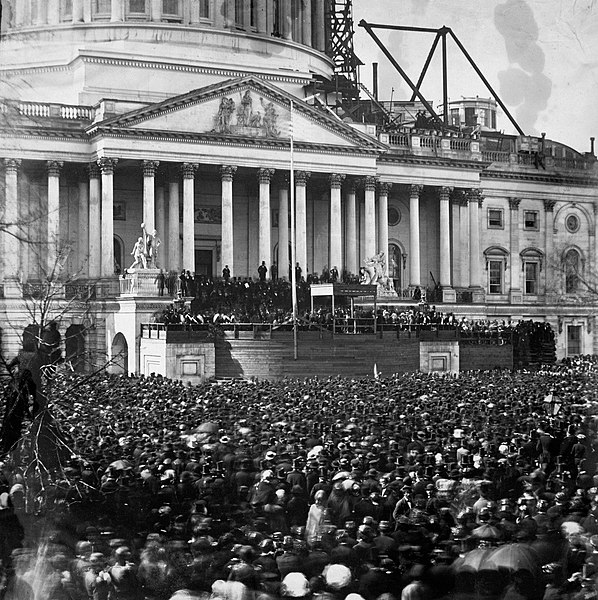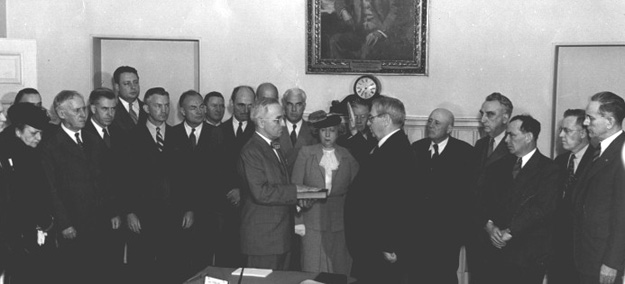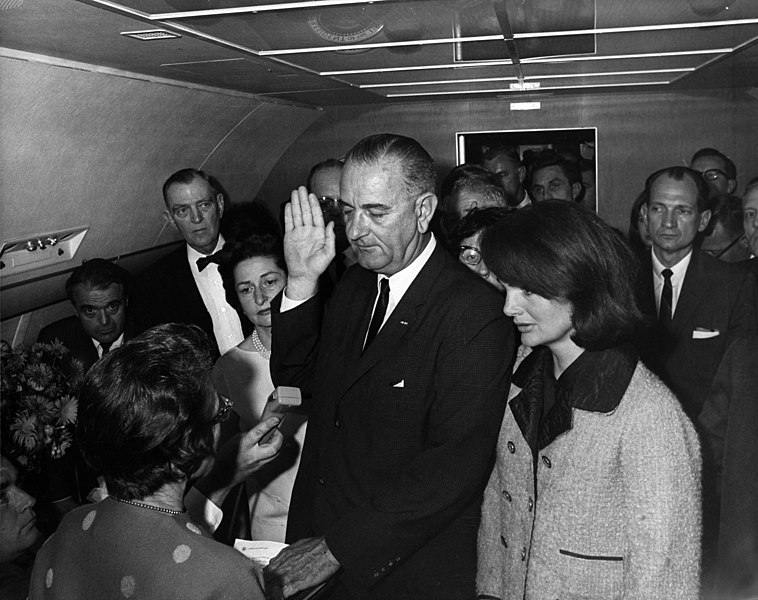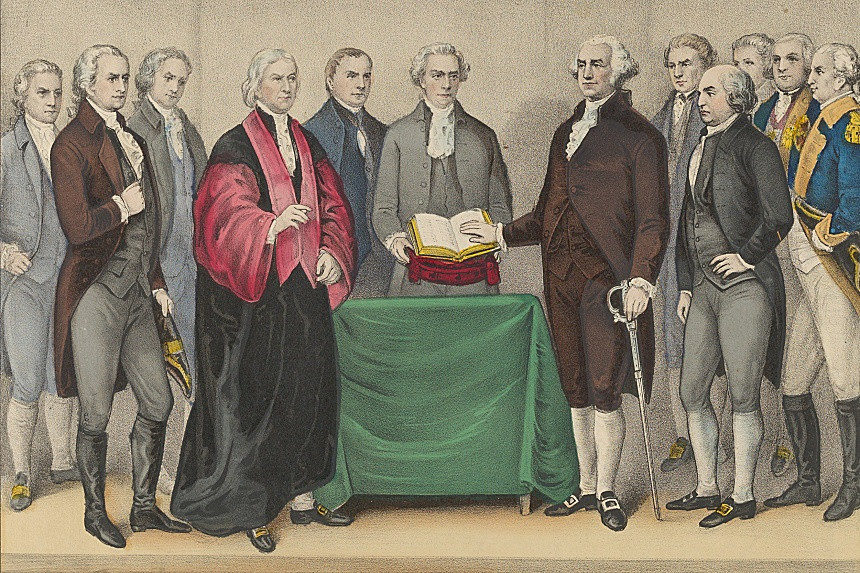History, it’s said, repeats itself.
Consider this observation from Lincoln’s inaugural ceremony: “The air was still thick with rumors of ‘rebel plots’ to assassinate Mr. Lincoln, or to capture him and carry him off before he could take hold of the reins of government.”
Feelings were running so high that Lincoln had to be almost smuggled into Washington, because of an apparent assassination plot. To throw would-be bad guys off, he wore a regular hat, not his stove pipe hat, and stooped, so as to appear shorter. (Tales that he was disguised as a woman were not true.) He was put up at the Willard Hotel, a block from the White House. After he became president, he used part of his first paycheck to pay the hotel bill.
He had been sworn in, guarded by General Winfield Scott, a celebrated war hero. “His carriage,” according to one account “was closely surrounded on all sides by marshals and cavalry, so as almost to hide it from view.”

It was the custom then, too, for the outgoing president to accompany the incoming president to the Capitol for the ceremony in a procession down Pennsylvania Avenue that started at the Willard Hotel. A 16-year-old named Julia Taft recalled, “As we took our places, a file of green-coated sharpshooters went through up to the roof. The whisper went round that they had received orders to shoot at any one crowding toward the President’s carriage.”
When the soon-to-be sixteenth president of the United States passed by in his carriage, riding with the outgoing president, James Buchanan, Julia heard a woman remark: “There goes that Illinois ape, the cursed Abolitionist. But he will never come back alive.”
So much for good wishes.
Good wishes have often been in short supply during these transitions of power, and I have personal knowledge of one, though in a less emotionally charged situation.
I heard the story from the Washington Bureau Chief Paul R. Leach when, as a relative newcomer working at the Chicago Daily News, I visited the bureau. Leach was a veteran, in the fullest and finest sense of the word, and at one point our conversation turned to the Daily News’s principal rival, the Chicago Tribune. Colonel Robert McCormick was the publisher, an eccentric man with strong views. Which he, despite good editorial policy, let creep into his newspaper’s news coverage, often displayed in boxed texts on page one.
Leach said Colonel McCormick was seated in the row just in front of him at the inauguration of President Franklin D. Roosevelt on March 4, 1933. The inauguration that is remembered for one of the most famous quotes in all of inaugural history: “The only thing we have to fear is fear itself.”
FDR’s inaugural address (Uploaded to YouTube by Speakers.com)
At some point, Colonel McCormick turned to the aide at his side and said, with a dismissive nod of his head to the new president: “He won’t do.”
Roosevelt would go on to be elected to the presidency in 1936, 1940, and 1945 — the only president to achieve that. He would be credited (even by some of his opponents) for pulling the nation out of the Great Depression and then leading it in wartime, so well that he was generally regarded as one of the greatest American presidents — in fact, one of the greatest leaders in the world — of the 20th century.
When he died April 12, 1945, it was a shock worthy of the Richter scale. I know what an impact it had even on seasoned newspapermen because I was a copygirl at the Daily News then, seated at the city desk as the day wore down, mere feet from the telegraph editor George Dodge. I did not notice him pull the old-fashioned, upright black candlestick telephone to him — the one the Associated Press used to alert editors to bulletins. But I saw him slowly push it back into place as he hung up the bell-shaped receiver and said softly, “Roosevelt is dead.”
He jumped up so quickly his chair went flying back into the glass bookcase behind him. The other editors came flying into the city room.
At the time, the vice president, Harry S. Truman, was up on Capitol Hill. He had just adjourned a session of the United States Senate and was about to enjoy a drink with Sam Rayburn, Speaker of the House, when he was summoned to the White House, where Mrs. Roosevelt told him the president was dead. He was sworn in at 7:00 p.m., Thursday, April 12, 1945, by Chief Justice Harlan F. Stone in the Cabinet Room, witnessed by members of the Cabinet.

Sudden deaths bring unexpected settings for the swearing in.
When President Warren G. Harding died of a heart attack in San Francisco while on a speaking tour, Vice President Calvin Coolidge was up in Vermont at the family home. It had no electricity or telephone. He received word of the president’s passing in the middle of the night from a messenger. He dressed, came downstairs to greet the reporters who’d gathered, and took the oath of office in the family parlor. It was administered by his father, a notary public and justice of the peace, by the light of a kerosene lamp at 2:47 a.m., the morning of August 3, 1923.
And no one of a certain age will ever forget the photo of Lyndon B. Johnson being sworn in on Air Force One at Love Field in Dallas, Texas, November 22, 1963, after the assassination of President John F. Kennedy. A stricken Jacqueline Kennedy is one of the witnesses, as is the new First Lady, Ladybird Johnson.

There have been stories great and small in the 200-plus years since George Washington raised his hand on the second floor balcony of Federal Hall on April 30, 1789, in New York City, it then being the nation’s capital. The first president of the United States, and first to take the oath of office, did so as a crowd assembled in the streets below to witness the historic event.
In his inaugural address, Washington was nervous and humble, but he clearly had faith that the United States would become a role model to other nations. He said, “The foundation of our national policy will be laid in the pure and immutable principles of private morality, and the preeminence of free government be exemplified by all the attributes which can win the affections of its citizens and command the respect of the world.”
Featured image: Currier & Ives 1876 lithograph of the first inauguration of George Washington. The Metropolitan Museum of Art, Bequest of Adele S. Colgate, 1962.
Become a Saturday Evening Post member and enjoy unlimited access. Subscribe now




Comments
Roosevelt was not re-elected in 1945. It was not an election year. He was re-elected in 1944
The whole thing went off without a hitch, fortunately. I’m sorry afterwards though our national guards were sent packed into an uncomfortable concrete parking lot. Otherwise, hopefully Biden will bulldoze what’s best for the American people right on through, bypassing the other Party completely. That’s exactly what they do for their agendas.
Well Val, I certainly hope and want everything to go smoothly tomorrow on Inauguration Day, but am frankly very nervous about it. I know Biden wants to be traditional, but I’m concerned about domestic terrorists infiltration; blending in, snipers and even programmed drones. I wish it were being held inside where there would be more control for safety, especially now, but they aren’t. Keep your fingers crossed.
The article otherwise is great, Val. You covered the highlights of the 19th and 20th centuries, one of which was FDR’s death while you were a copygirl at the Chicago Daily News. I think probably one of the big reasons it was shocking for you is because he was the only President you knew for most of your life, being 19 in ’45. Over 12 years! 12 exremely tumultuous years with the Depression then World War II. There were only 2 before him, with one you’d be barely be old enough to remember.
By the time I was 19, we were on our 6th President (IKE to Carter) and 6 since (Reagan to Trump) spread over the next 40 years. I didn’t know Harding had died while in office; just FDR in the 20th. Not counting JFK because he was assassinated; far different than simply ‘dying’ as we know.
As a nation I hope we can live up to Washington’s inaugural address or continue to always strive to. We have to start putting our own people first, not giving billions of dollars to nations that hate us, spending trillions on unnecessary, endless wars, two parties that are puppets of Wall Street and corporate America’s strings. If we are to progress as a nation, this has to change. Our nation is in a period of being a failed state due to the above and more. Let us learn to incorporate the best aspects of what works in other nations, and throw out what clearly isn’t here. It won’t be easy, nothing worthwhile ever is. Don’t the American people, the nation’s backbone, deserve the best?